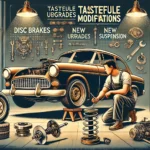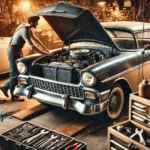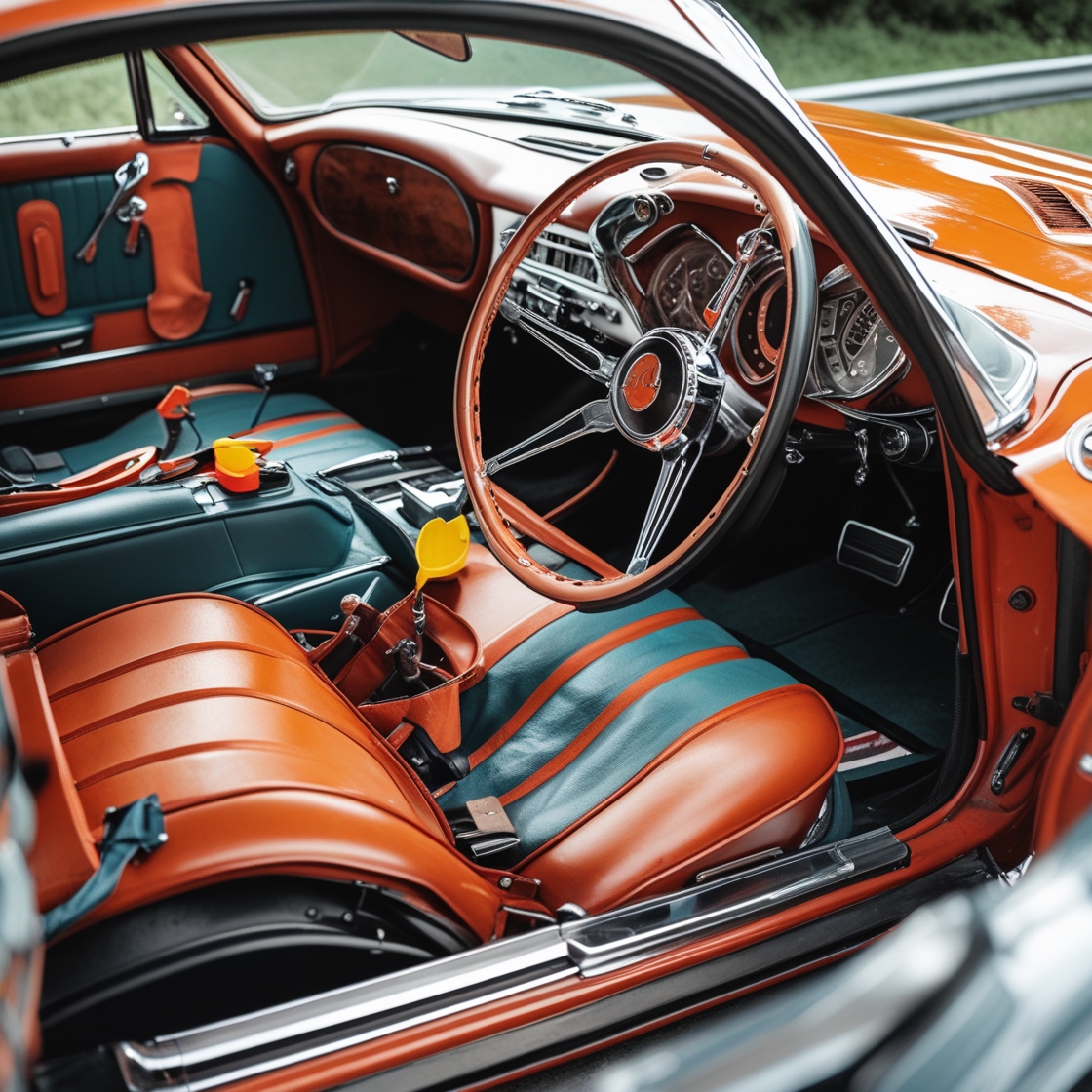Selling a classic car is different from selling a modern vehicle. Whether you’re upgrading your collection, funding a new project, or simply ready to part ways with your vintage ride, getting the best price requires preparation, presentation, and strategy. In this guide, we’ll walk you through the steps to sell your classic car like a pro.
1. Know Your Car’s Value
Before listing your car, it’s essential to understand what it’s worth in the current market.
📊 How to Determine Value:
- Research recent sales of similar models using platforms like Hemmings, Classic.com, or Bring a Trailer.
- Use valuation tools from Hagerty or NADA Guides.
- Consider hiring a professional appraiser for rare or high-value cars.
🎯 What Affects the Price:
- Rarity and production numbers
- Matching numbers (engine, transmission, chassis)
- Restoration quality and originality
- Documented maintenance and ownership history
Pro Tip: Cars with full documentation and original parts (even in worn condition) tend to fetch higher prices.
2. Gather All Documentation
Buyers of classic cars want proof of history and maintenance. Organize everything before listing the vehicle.
📁 What to Include:
- Title or registration papers
- Maintenance and restoration records
- Appraisals or inspection reports
- Original owner’s manuals or brochures
- Build sheets or factory documentation (if available)
Pro Tip: Create a digital and printed copy of your documentation to share with potential buyers.
3. Prepare the Car for Sale
First impressions matter. A well-presented classic car sells faster—and for more.
🧼 Detail the Vehicle:
- Wash, wax, and polish the exterior.
- Deep-clean the interior and engine bay.
- Touch up minor paint chips or scratches if possible.
🔧 Perform Basic Maintenance:
- Change the oil and check all fluids.
- Ensure the tires are in good condition.
- Fix minor issues that could raise red flags (e.g., squeaky brakes or warning lights).
Pro Tip: Don’t overspend on major repairs unless they offer a clear return on investment.
4. Take High-Quality Photos
Great photos help your listing stand out and attract serious buyers.
📸 Tips for Great Photos:
- Use natural light and avoid harsh shadows.
- Shoot from multiple angles: front, rear, side, interior, engine bay, trunk, and undercarriage.
- Highlight unique features and imperfections honestly.
- Include close-ups of VIN plates and identification tags.
Pro Tip: Consider a professional photographer for rare or high-value vehicles.
5. Write a Compelling Listing
An effective description helps potential buyers connect emotionally and make informed decisions.
🖊 What to Include in the Description:
- Year, make, and model
- Trim level, engine specs, and transmission
- Restoration history and any upgrades
- Mileage (original or since restoration)
- Notable awards or show history
- Asking price and location
T Be honest and informative, not pushy. Transparency builds trust.
6. Choose the Right Platform to Sell
Where you list your car affects how quickly it sells and how much you earn.
💻 Best Places to Sell Classic Cars:
- Onlin: Bring a Trailer, Cars & Bids, eBay Motors
Great for rare or unique classics. - Classified Websites: Hemmings, ClassicCars.com, AutoTrader Classics
Ideal for wide exposure and enthusiast audiences. - Social Me: Facebook Marketplace, car groups, or Instagram
Good for local buyers and quick interest. - Classic Car Dealers: For a faster, hands-off transaction
Convenient but may offer lower payouts. - Car Shows & Swap Meets:
Excellent for connecting with serious collectors.
Pro Tip: Combine listings on multiple platforms to increase visibility.
7. Be Ready to Negotiate
Most buyers will want to negotiate—be prepared with a strategy.
🤝 Tips for Negotiation:
- Set a realistic a with room to move slightly.
- Know your bottom line—the minimum you’ll accept.
- Be polite but firm. Don’t rush a sale out of impatience.
- Use evidence: share valuation reports and maintenance records to justify your price.
Pro Tip: If a buyer is serious, they will ask meaningful questions—not just lowball offers.
8. Handle the Transaction Securely
When it’s time to close the deal, make sure the transaction is safe and legal.
💼 Final Steps:
- Accept secure payment methods: bank transfer or certified cashier’s check.
- Avoid accepting personal checks or large sums of cash from strangers.
- Complete a Bill of Sale including both parties’ names, VIN, sale price, and date.
- Transfer the title and remove your plates if required in your jurisdiction.
Pro Tip: If selling internationally, consult a shipping agent or export expert to handle documentation and logistics.
9. Offer Delivery or Shipping Assistance
Providing delivery options can expand your buyer pool—especially for rare classics.
🚚 Options:
- Work with a reputable enclosed vehicle transporter.
- Offer to assist the buyer in coordinating pick-up or shipping.
- Be clear about who is responsible for shipping costs.
Pro Tip: If the buyer is local, offering a test drive with proof of insurance can help seal the deal.
10. Follow Up After the Sale
A little professionalism goes a long way.
✅ What to Do:
- Confirm that the buyer received all documents.
- Leave a note of thanks or a care tip if you want to build a good reputation in the car community.
- Update your records and insurance policy to reflect the sale.
Final Thoughts
Selling a classic car isn’t just about the transaction—it’s about finding the right buyer who will value the vehicle as much as you did. With proper preparation, clear communication, and the right platform, you can sell your classic for a great price while giving it a worthy new home.
Selling a classic car is different from selling a modern vehicle. Whether you’re upgrading your collection, funding a new project, or simply ready to part ways with your vintage ride, getting the best price requires preparation, presentation, and strategy. In this guide, we’ll walk you through the steps to sell your classic car like a pro.
1. Know Your Car’s Value
Before listing your car, it’s essential to understand what it’s worth in the current market.
📊 How to Determine Value:
- Research recent sales of similar models using platforms like Hemmings, Classic.com, or Bring a Trailer.
- Use valuation tools from Hagerty or NADA Guides.
- Consider hiring a professional appraiser for rare or high-value cars.
🎯 What Affects the Price:
- Rarity and production numbers
- Matching numbers (engine, transmission, chassis)
- Restoration quality and originality
- Documented maintenance and ownership history
Pro Tip: Cars with full documentation and original parts (even in worn condition) tend to fetch higher prices.
2. Gather All Documentation
Buyers of classic cars want proof of history and maintenance. Organize everything before listing the vehicle.
📁 What to Include:
- Title or registration papers
- Maintenance and restoration records
- Appraisals or inspection reports
- Original owner’s manuals or brochures
- Build sheets or factory documentation (if available)
Pro Tip: Create a digital and printed copy of your documentation to share with potential buyers.
3. Prepare the Car for Sale
First impressions matter. A well-presented classic car sells faster—and for more.
🧼 Detail the Vehicle:
- Wash, wax, and polish the exterior.
- Deep-clean the interior and engine bay.
- Touch up minor paint chips or scratches if possible.
🔧 Perform Basic Maintenance:
- Change the oil and check all fluids.
- Ensure the tires are in good condition.
- Fix minor issues that could raise red flags (e.g., squeaky brakes or warning lights).
Pro Tip: Don’t overspend on major repairs unless they offer a clear return on investment.
4. Take High-Quality Photos
Great photos help your listing stand out and attract serious buyers.
📸 Tips for Great Photos:
- Use natural light and avoid harsh shadows.
- Shoot from multiple angles: front, rear, side, interior, engine bay, trunk, and undercarriage.
- Highlight unique features and imperfections honestly.
- Include close-ups of VIN plates and identification tags.
Pro Tip: Consider a professional photographer for rare or high-value vehicles.
5. Write a Compelling Listing
An effective description helps potential buyers connect emotionally and make informed decisions.
🖊 What to Include in the Description:
- Year, make, and model
- Trim level, engine specs, and transmission
- Restoration history and any upgrades
- Mileage (original or since restoration)
- Notable awards or show history
- Asking price and location
T Be honest and informative, not pushy. Transparency builds trust.
6. Choose the Right Platform to Sell
Where you list your car affects how quickly it sells and how much you earn.
💻 Best Places to Sell Classic Cars:
- Onlin: Bring a Trailer, Cars & Bids, eBay Motors
Great for rare or unique classics. - Classified Websites: Hemmings, ClassicCars.com, AutoTrader Classics
Ideal for wide exposure and enthusiast audiences. - Social Me: Facebook Marketplace, car groups, or Instagram
Good for local buyers and quick interest. - Classic Car Dealers: For a faster, hands-off transaction
Convenient but may offer lower payouts. - Car Shows & Swap Meets:
Excellent for connecting with serious collectors.
Pro Tip: Combine listings on multiple platforms to increase visibility.
7. Be Ready to Negotiate
Most buyers will want to negotiate—be prepared with a strategy.
🤝 Tips for Negotiation:
- Set a realistic a with room to move slightly.
- Know your bottom line—the minimum you’ll accept.
- Be polite but firm. Don’t rush a sale out of impatience.
- Use evidence: share valuation reports and maintenance records to justify your price.
Pro Tip: If a buyer is serious, they will ask meaningful questions—not just lowball offers.
8. Handle the Transaction Securely
When it’s time to close the deal, make sure the transaction is safe and legal.
💼 Final Steps:
- Accept secure payment methods: bank transfer or certified cashier’s check.
- Avoid accepting personal checks or large sums of cash from strangers.
- Complete a Bill of Sale including both parties’ names, VIN, sale price, and date.
- Transfer the title and remove your plates if required in your jurisdiction.
Pro Tip: If selling internationally, consult a shipping agent or export expert to handle documentation and logistics.
9. Offer Delivery or Shipping Assistance
Providing delivery options can expand your buyer pool—especially for rare classics.
🚚 Options:
- Work with a reputable enclosed vehicle transporter.
- Offer to assist the buyer in coordinating pick-up or shipping.
- Be clear about who is responsible for shipping costs.
Pro Tip: If the buyer is local, offering a test drive with proof of insurance can help seal the deal.
10. Follow Up After the Sale
A little professionalism goes a long way.
✅ What to Do:
- Confirm that the buyer received all documents.
- Leave a note of thanks or a care tip if you want to build a good reputation in the car community.
- Update your records and insurance policy to reflect the sale.
Final Thoughts
Selling a classic car isn’t just about the transaction—it’s about finding the right buyer who will value the vehicle as much as you did. With proper preparation, clear communication, and the right platform, you can sell your classic for a great price while giving it a worthy new home.








